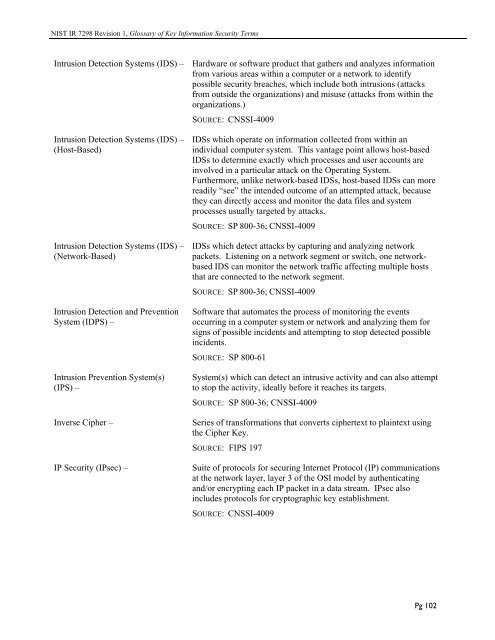NISTIR 7298 Revision 1, Glossary of Key Information Security Terms
NISTIR 7298 Revision 1, Glossary of Key Information Security Terms
NISTIR 7298 Revision 1, Glossary of Key Information Security Terms
You also want an ePaper? Increase the reach of your titles
YUMPU automatically turns print PDFs into web optimized ePapers that Google loves.
NIST IR <strong>7298</strong> <strong>Revision</strong> 1, <strong>Glossary</strong> <strong>of</strong> <strong>Key</strong> <strong>Information</strong> <strong>Security</strong> <strong>Terms</strong><br />
Intrusion Detection Systems (IDS) – Hardware or s<strong>of</strong>tware product that gathers and analyzes information<br />
from various areas within a computer or a network to identify<br />
possible security breaches, which include both intrusions (attacks<br />
from outside the organizations) and misuse (attacks from within the<br />
organizations.)<br />
SOURCE: CNSSI-4009<br />
Intrusion Detection Systems (IDS) –<br />
(Host-Based)<br />
Intrusion Detection Systems (IDS) –<br />
(Network-Based)<br />
Intrusion Detection and Prevention<br />
System (IDPS) –<br />
Intrusion Prevention System(s)<br />
(IPS) –<br />
IDSs which operate on information collected from within an<br />
individual computer system. This vantage point allows host-based<br />
IDSs to determine exactly which processes and user accounts are<br />
involved in a particular attack on the Operating System.<br />
Furthermore, unlike network-based IDSs, host-based IDSs can more<br />
readily “see” the intended outcome <strong>of</strong> an attempted attack, because<br />
they can directly access and monitor the data files and system<br />
processes usually targeted by attacks.<br />
SOURCE: SP 800-36; CNSSI-4009<br />
IDSs which detect attacks by capturing and analyzing network<br />
packets. Listening on a network segment or switch, one networkbased<br />
IDS can monitor the network traffic affecting multiple hosts<br />
that are connected to the network segment.<br />
SOURCE: SP 800-36; CNSSI-4009<br />
S<strong>of</strong>tware that automates the process <strong>of</strong> monitoring the events<br />
occurring in a computer system or network and analyzing them for<br />
signs <strong>of</strong> possible incidents and attempting to stop detected possible<br />
incidents.<br />
SOURCE: SP 800-61<br />
System(s) which can detect an intrusive activity and can also attempt<br />
to stop the activity, ideally before it reaches its targets.<br />
SOURCE: SP 800-36; CNSSI-4009<br />
Inverse Cipher – Series <strong>of</strong> transformations that converts ciphertext to plaintext using<br />
the Cipher <strong>Key</strong>.<br />
SOURCE: FIPS 197<br />
IP <strong>Security</strong> (IPsec) –<br />
Suite <strong>of</strong> protocols for securing Internet Protocol (IP) communications<br />
at the network layer, layer 3 <strong>of</strong> the OSI model by authenticating<br />
and/or encrypting each IP packet in a data stream. IPsec also<br />
includes protocols for cryptographic key establishment.<br />
SOURCE: CNSSI-4009<br />
Pg 102

















